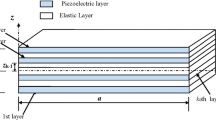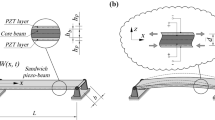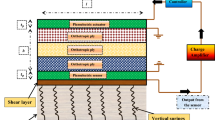Summary
The present paper is devoted to the coupling between electrical and mechanical fields in piezoelastic structures. In the present contribution, an electromechanically coupled technical theory for flexural and extensional deformations of piezoelastic composite beams is developed. Such a technical theory should be of special interest for control applications, where a lower-order but sufficiently accurate modelling is required.
In a first step, an equivalent single-layer theory of the Timoshenko-type for composite beams is utilized. The influence of shear, rotatory inertia as well as the influence of the electric field is taken into account in this technical beam theory. The electric field is unspecified so far in this formulation, but is coupled to the deformation by means of the charge equation of electrostatics. In order to incorporate this coupling, the electric potential is approximated by a power series in the thickness direction of the beam. Terms up to an order of two are considered in the approximation. The formulation then is adapted to the electric boundary conditions at the upper and lower sides of the electroded piezoelectric layers, namely that the electrodes have to be equipotential areas. Putting this distribution into an electrical variational principle, a weak one-dimensional formulation of the charge equation of electrostatics is obtained for the axial distribution of the electric potential. Prescribing the electric potential at the electrodes, and specifying the electrical boundary conditions at the vertical ends of the layer, this weak form completes the proposed electromechanically coupled technical theory for composite piezoelastic beams.
In order to demonstrate the influence of the coupling between deformation and electric field, the quasi-static behavior and free flexural vibrations of a symmetrically laminated 3-layer beam are studied in detail. Results are compared to results of coupled finite element computations as well as to results obtained by a simplified theory, previously developed by the authors.
Similar content being viewed by others
References
Crawley, E. F.: Intelligent structures for aerospace: A technology overwiev and assessment. AIAA J.32, 1689–1699 (1994).
Tani, J., Takagi, T., Qiu, J.: Intelligent material system: Application of functional materials. Appl. Mech. Rev.51, 505–521 (1998).
Tzou, H. S.: Multifield transducers, devices, mechatronic systems and structronic systems with smart materials. The Shock and Vibration Digest30, 282–294 (1998).
Rao, S. S., Sunar, M.: Piezoelectricity and its use in disturbance sensing and control of flexible structures: A survey. Appl. Mech. Rev.47, 113–123 (1994).
Tauchert, T. R.: Thermal stresses in plates-statical problems. In: Thermal stresses I (Hetnarski, R. B., ed.) pp. 23–141. Amsterdam: Elsevier 1986.
Lee, C.-K.: Theory of laminated piezoelectric plates for the design of distributed sensor/actuators. Part I: Governing equations and reciprocal relationships. J Acoust. Soc. Am.87, 1144–1158 (1990).
Miu, D. K.: Mechatronics: Electromechanics and contromechanics. New York: Springer 1993.
Tzou, H. S.: Piezoelectric shells — distributed sensing and control of continua. Dordrecht: Kluwer 1993.
Tauchert, T. R.: Piezothermoelastic behavior of a laminated plate. J. Thermal Stresses15, 25–37 (1992).
Vinson, J. R.: The behavior of shells composed of isotropic and composite materials. Dordrecht: Kluwer 1993.
Mura, T.: Micromechanics of defects in solids, 2nd ed. Dordrecht: Kluwer 1991.
Reddy, J. N.: A simple higher-order theory for laminated composite plates. J. Appl. Mech.51, 745–752 (1984).
Chandrashekhara, K., Agrawal, A. N.: Active vibration control of laminated composite plates using piezoelectric devices: A finite element approach. J. Intelligent Mat. Syst. Struct.4, 496–508 (1993).
Chandrashekhara, K., Donthireddy, P.: Vibration suppression of composite beams with piezoelectric devices using higher order theory. Euro. J. Mech. A/Solids16, 709–721 (1997).
Tiersten, H. F.: Equations for the extension and flexure of relatively thin electroelastic plates undergoing large electric field. In: Mechanics of electromagnetic materials and structures (Lee, J. S., Maugin, G. A., Shindo, Y., eds.), pp. 21–34. New York: ASME, AMD 161, MD42 (1993).
Yang, J. S., Batra, R. C.: A theory of electroded thin thermopiezoelectric plates subject to large driving voltages. J. Appl. Phys.76, 5411–5417 (1994).
Yang, J. S.: Equations for the extension and flexure of electroelastic plates under strong electric fields. Int. J. Solids Struct.36, 3171–3192 (1999).
Lee, H.-J., Saravanos, D. A.: A mixed multi-field finite element formulation for thermopiezoelectric composite shells. Int. J. Solids Struct.37, 4949–4967 (2000).
Saravanos, D. A.: Passively damped laminated piezoelectric shell structures with integrated electric networks. AIAA-J.38, 1260–1268 (2000).
Mitchell, J. A., Reddy, J. N.: A refined hybrid plate theory for composite laminates with piezoelectric laminae. Int. J. Solids Struct.32, 2345–2367 (1995).
Tzou, H. S., Ye, R.: Analysis of piezoelastic structures with laminated piezoelectric triangle shell elements. AIAA-J.34, 110–115 (1996).
Heyliger, P., Pei, K. C., Saravanos, D.: Layerwise mechanics and finite element model for laminated piezoelectric shells. AIAA-J.34, 2353–2360 (1996).
Heyliger, P.: Exact solutions for simply supported laminated piezoelectric plates. J. Appl. Mech.64, 299–306 (1997).
Heyliger, P., Saravanos, D. A.: Exact free-vibration analysis of laminated plates with embedded piezoelectric layers. J. Acoust. Soc. Am.98, 1547–1557 (1995).
Ashida, F., Choi, J.-S., Noda, N.: An inverse thermoelastic problem in an isotropic plate associated with a piezoelectric ceramic plate. J. of Thermal Stresses19, 153–167 (1996).
Saravanos, D. A., Heyliger, P. R.: Mechanics and computational models for laminated piezoelectric beams, plates, and shells. Appl. Mech. Rev.52, 305–320 (1999).
Krommer, M., Irschik, H.: On the influence of the electric field on free transverse vibrations of smart beams. Smart Mat. Struc.8, 401–410 (1999).
Tiersten, H. F.: Linear piezoelectric plate vibrations. New York: Plenum 1969.
Parkus, H.: Variational principles in thermo- and magneto-elasticity. New York: Springer 1970.
Ziegler, F.: Mechanics of solids and fluids. 2nd ed., New York: Springer 1995. Corr. 2nd printing 1998.
Timoshenko, S. P.: On the correction of shear of the differential equations for transverse vibrations of prismatic bars. Phil. Mag.41, 744–746 (1921).
Krommer, M., Irschik, H.: A Reissner-Mindlin-type plate theory including the direct piezoelectric and the pyroelectric effect. Acta Mech.141, 51–69 (2000).
Ling-Hui, H.: Axisymmetric response of circular plates with piezoelectric layers: An exact solution. Int. J. Mech. Sci.40, 1265–1279 (1998).
Rogacheva, N.: Piezoelectric adaptive mirrors. Proc. of the Euromech 373 Colloquium, Modelling and Control of Adaptive Mechanical Structures, March 11–13, 1998, Magdeburg. VDI Fortschritt-Berichte Reihe 11, Nr. 268, 165–174 (1998).
Tiersten, H. F.: Electroelastic equations for electroded thin plates subject to large driving voltages. J. Appl. Phys.74, 3389–3393 (1993).
Author information
Authors and Affiliations
Rights and permissions
About this article
Cite this article
Krommer, M., Irschik, H. An electromechanically coupled theory for piezoelastic beams taking into account the charge equation of electrostatics. Acta Mechanica 154, 141–158 (2002). https://doi.org/10.1007/BF01170704
Received:
Issue Date:
DOI: https://doi.org/10.1007/BF01170704




